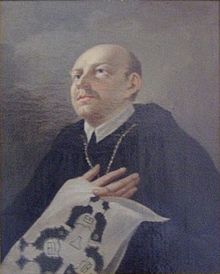Maximilian Pagl

Maximilian Pagl (born May 21, 1668 in Stadl-Paura ; † February 23, 1725 ) was abbot of Lambach Abbey in Lambach , Upper Austria , from 1705 to 1725 .
Life
Maximilian Pagl was born as Johannes Pagl in Stadl-Paura as the son of the Stadlinger Zillenhüters Balthasar Pagl. The birthplace now houses the ship's museum . In 1687 he entered the Lambach monastery, studied theology and law at the University of Salzburg and was ordained a priest in 1695. On February 10, 1705 he was elected 44th abbot of Lambach Abbey and chose the religious name Maximilian.
Because of his frequent trips to Linz, he had a house and stables built near Wels, the so-called Maxlheiderhaus. The name of the house is made up of his religious name Maximilian and the location, the Welser Heide. This area is still called Maxlhaid today, sometimes the spelling Maxlheid is also common. Abbot Maximilian Pagl also made a significant contribution to the fertility of the Wels Heath by planting pines in this area.
Initiated structures
Many extensions to the Lambach monastery go back to the art-loving abbot of the Lambach monastery.
- Completion of the north wing with the summer refectory and the ambulatory above, builder: Carlo Antonio Carlone , plasterer: Diego Francesco Carlone
- Erecting the high altar in the collegiate church
- Enlargement of the pen library
- Redesign of the monastery gardens and establishment of a dwarf garden with baroque dwarf sculptures (1715) in the convent garden
- Establishment of the monastery pharmacy (1724), which was moved to the market square in 1794.
The abbot also had a number of baroque buildings built in the vicinity of the monastery.
- The Gothic cemetery church (former parish church) was converted to baroque style.
- June 30, 1717: Laying of the foundation stone for the Trinity Column in Linz
- 1717–1719: Construction of the Maria-Hilf-Chapel on the Puchberg (ground plan: Siebeneck)
- 1717–1722: Construction of the Kalvarienbergkirche on the Pfisterberg (floor plan: cross shape)
- 1714–1724: Construction of the Trinity Church (Paurakirche) in Stadl-Paura (floor plan: triangle), builder: Johann Michael Prunner . The Holy Trinity Church in Stadl-Paura was built as thanks for the fact that the area was spared the plague.
literature
- Arno Eilenstein: Abbot Maximilian Pagl von Lambach and his diary (1705–1725). Lambach Abbey, 1920
Web links
- Maximilian Pagl in the Biographia Benedictina (Benediktinerlexikon.de)
| personal data | |
|---|---|
| SURNAME | Pagl, Maximilian |
| ALTERNATIVE NAMES | Pagl, Johannes |
| BRIEF DESCRIPTION | Austrian Benedictine, abbot of Lambach Abbey |
| DATE OF BIRTH | May 21, 1668 |
| PLACE OF BIRTH | Stadl-Paura |
| DATE OF DEATH | February 23, 1725 |



